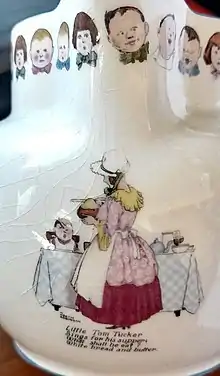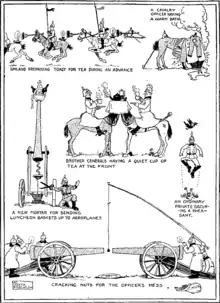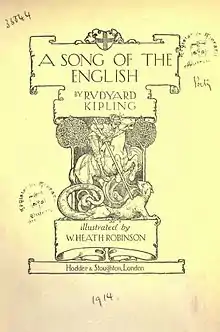W. Heath Robinson
William Heath Robinson (31 May 1872 – 13 September 1944) was an English cartoonist, illustrator and artist, best known for drawings of whimsically elaborate machines to achieve simple objectives.[1]
W. Heath Robinson | |
|---|---|
 | |
| Born | 13 May 1872 Islington, England |
| Died | 13 September 1944 (aged 72) London, England |
| Nationality | British |
| Occupation | Illustrator, cartoonist and artist |
| Known for | Drawings of odd contraptions |
In the UK, the term "Heath Robinson contraption" gained dictionary recognition around 1912.[2] It became part of popular language during the 1914–1918 First World War as a description of any unnecessarily complex and implausible contrivance. Other cartoonists drew on similar themes, by 1928 the American Rube Goldberg was known for "Rube Goldberg machines" in the United States. "Heath Robinson contraption" is perhaps most commonly used in relation to temporary fixes using ingenuity and whatever is to hand, often string and tape, or unlikely cannibalisations. Its continuing popularity was undoubtedly linked to Britain's shortages and the need to "make do and mend" during the Second World War.
Early life
-('Uncle_Lubin').jpg.webp)
William Heath Robinson was born at 25 Ennis Road on 13 May 1872 into a family of artists in an area of London known as Stroud Green, Finsbury Park, North London. His father Thomas Robinson (1838–1902) and brothers Thomas Heath Robinson (1869–1954) and Charles Robinson (1870–1937) all worked as illustrators.
Career
His early career involved illustrating books – among others: Hans Christian Andersen's Danish Fairy Tales and Legends (1897), The Arabian Nights (1899), Tales from Shakespeare (1902), Gargantua and Pantagruel (1904),[3] Twelfth Night (1908), Andersen's Fairy Tales (1913), A Midsummer Night's Dream (1914), Charles Kingsley's The Water-Babies (1915) and Walter de la Mare's Peacock Pie (1916). Robinson was one of the leading illustrators selected by Percy Bradshaw for inclusion in his The Art of the Illustrator (1917-1918) which presented a separate portfolio for each of twenty illustrators.[note 1]
Robinson also served as a consultant at the Percy Bradshaw's The Press Art School, a school teaching painting, drawing, and illustration by corresponcence. The consultants commented on the work submitted by the students.[6]:32 In the course of his work, Robinson also wrote and illustrated three children's books, The Adventures of Uncle Lubin (1902), Bill the Minder (1912) and Peter Quip in Search of a Friend (1922). Uncle Lubin is regarded as the start of his career in the depiction of unlikely machines.
During the First World War, he drew large numbers of cartoons, depicting ever-more-unlikely secret weapons being used by the combatants. He also depicted the American Expeditionary Force in France.[7] His work was also part of the painting event in the art competition at the 1932 Summer Olympics.[8]
He also produced a steady stream of humorous drawings for magazines and advertisements. In 1934 he published a collection of his favourites as Absurdities, such as:
- "The Wart Chair. A simple apparatus for removing a wart from the top of the head"
- "Resuscitating stale railway scones for redistribution at the station buffets"
- "The multimovement tabby silencer", which automatically threw water at serenading cats
Most of his cartoons have since been reprinted many times in multiple collections.
The machines he drew were frequently powered by steam boilers or kettles, heated by candles or a spirit lamp and usually kept running by balding, bespectacled men in overalls. There would be complex pulley arrangements, threaded by lengths of knotted string. Robinson's cartoons were so popular that in Britain the term "Heath Robinson" is used to refer to an improbable, rickety machine barely kept going by incessant tinkering. (The corresponding term in the U.S. is Rube Goldberg, after the American cartoonist born just over a decade later, with an equal devotion to odd machinery. Similar "inventions" have been drawn by cartoonists in many countries, with the Danish Storm Petersen being on par with Robinson and Goldberg.)
One of his most famous series of illustrations was that which accompanied the first Professor Branestawm book written by Norman Hunter. The stories told of the eponymous professor who was brilliant, eccentric and forgetful and provided a perfect backdrop for Robinson's drawings.

In around 1928[9] Robinson was commissioned to design a range of nursery ware for W.R. Midwinter, a Staffordshire pottery firm. Scenes from sixteen nursery rhymes (some illustrated with more than one vignette) were printed on ware ranging from eggcups to biscuit barrels, each with a decorative border of characterful children's faces. Titled "Fairyland on China", the range was favourably reviewed in the trade press.[10]
The last project Robinson worked on shortly before he died was illustrations for Lilian M. Clopet's short story collection Once Upon a Time, which was published in 1944.[11]
One of the automatic analysis machines built for Bletchley Park during the Second World War to assist in the decryption of German message traffic was named "Heath Robinson" in his honour. It was a direct predecessor to the Colossus, the world's first programmable digital electronic computer.
Personal life
In 1903 he married Josephine Latey, the daughter of newspaper editor John Latey.[12] Heath Robinson moved to Pinner, Middlesex, in 1908. His house in Moss Lane is commemorated by a blue plaque.[13]
Death and legacy
He died in September 1944, during the Second World War, and is buried in East Finchley Cemetery.
The Heath Robinson Museum opened in October 2016 to house a collection of nearly 1,000 original artworks owned by The William Heath Robinson Trust. The museum is in Memorial Park, Pinner, close to where the artist lived and worked.
In popular culture


The name "Heath Robinson" became part of common parlance in the UK for complex inventions that achieved absurdly simple results following its use as services slang during the 1914–1918 First World War.[14]
In the Wallace and Gromit films, Wallace often invents Heath Robinson-like machines, with some inventions being direct references.[15]
During the Falklands War (1982), British Harrier aircraft lacked their conventional "chaff"-dispensing mechanism.[16] Therefore, Royal Navy engineers designed an impromptu delivery system of welding rods, split pins and string which allowed six packets of chaff to be stored in the speedbrake well and deployed in flight. Due to its improvised and ramshackle nature it was often referred to as the "Heath Robinson chaff modification".[17]
Publications
- Robinson, W. Heath, Works of Edgar Allan Poe, Bell. 1900
- Robinson, W. Heath, Uncle Lubin, Richards. 1902
- Robinson, W. Heath, Adventures of Don Quixote, J.M. Dent. 1902
- Robinson, W. Heath, Bill the Minder, Constable & Co., London, 1912
- Robinson, W. Heath, Some "Frightful" War Pictures, Duckworth. 1915
- Robinson, W. Heath, Hunlikely!, Duckworth. 1916
- Robinson, W. Heath, The Saintly Hun: a book of German virtues, Duckworth. 1917
- Robinson, W. Heath, Flypapers, Duckworth. 1919
- Robinson, W. Heath, The Rabelais, Rabelais. [Private Printing] 1921
- Robinson, W. Heath, Peter Quip in Search of a Friend, Partridge 1921
- Robinson, W. Heath, Humours of Golf, Methuen. 1923, [Duckworth. 1973, ISBN 978-0-7156-0915-6]
- Robinson, W. Heath, Heath Robinson's Book of Goblins, Hutchinson & Co, London, 1934
- Robinson, W. Heath, Absurdities: A Book of Collected Drawings, Hutchinson. 1934, [Duckworth. 1975, ISBN 978-0-7156-0920-0]
- Robinson, W. Heath, Railway Ribaldry, Duckworth. 1935, [Duckworth. 1997, ISBN 978-0-7156-0823-4]
- Robinson, W. Heath, How to Live in Flat, Hutchinson. 1936, [Duckworth. 1976]
- Robinson, W. Heath, How to be a Perfect Husband, Hutchinson & Co, London, 1937
- Robinson, W. Heath, How to Make a Garden Grow, Hutchinson & Co, London, 1938
- Robinson, W. Heath, How to be a Motorist, Hutchinson & Co, London 1939
- Robinson, W. Heath, My Line of Life, Blackie & Sons. 1938
- Robinson, W. Heath, Let's Laugh: A Book of Humorous Inventions, Hutchinson. 1939
- Robinson, W. Heath, Heath Robinson at War, Methuen. 1942
- Clopet, Lilian M., illustrated by W. Heath Robinson, Once Upon a Time. 1944
- Lewis, John. Heath Robinson Artist and Comic Genius, Barnes and Noble. 1973
- Robinson, W. Heath, Inventions, Duckworth. 1973, ISBN 978-0-7156-0724-4
- De Freitas, Leo John, The Fantastic Paintings of Charles and William Heath Robinson, Peacock/Bantam. 1976
- Robinson, W. Heath, Devices, Duckworth. 1977, ISBN 978-0-7156-1268-2
- Beare, Geoffrey. The Illustrations of W. Heath Robinson, Werner Shaw. 1983
- Beare, Geoffrey. W. Heath Robinson, Chris Beetles. 1987
- Hamilton, James, William °Heath Robinson, Pavilion. 1992
- Beare, Geoffrey, The Brothers Robinson, Chris Beetles. 1992
- Beare, Geoffrey, The Art of William Heath Robinson, Dulwich Picture Gallery. 2003
- Robinson, W. Heath, Contraptions, Duckworth. 2007
- Robinson, W. Heath, Britain at Play, Duckworth. 2008
- Beare, Geoffrey, Heath Robinson's Commercial Art, Lund Humphries, 2017
- Hart-Davis, Adam, Very Heath Robinson, Sheldrake Press. 2017
See also
- Norman Hunter (author)
- Professor Branestawm
- Rube Goldberg, American artist with similar cartoon inventions
- Storm P., Danish artist with similar cartoon inventions
- Rowland Emett, British cartoonist with similar physical inventions
Notes
- The portfolio contained: a brief biography of Robinson, an illustration of Robinson at work in his studio, an explanation of Robinson's method of working. This was accompanied by a plate showing an illustration typical of his work and five other plates showing the work at five earlier stages of its production, from the first rough to the just before the finished drawing or colour sketch.[4] Robinson's coloured illustration shows a fantasy feast with naked cherubs.[5]
References
- Bryant, Mark. World War I in Cartoons. London: Grub Street Pub, 2006, page 17, ISBN 190494356X
- History – Historic Figures: William Heath Robinson (1872–1944) Archived 2019-10-27 at the Wayback Machine. BBC. Retrieved on 2011-05-06.
- The Works of Mr. Francis Rabelais published by Grant Richards, London, 1904. Reprinted by The Navarre Society, London, 1921
- "The Connisseur Bookself". The Connoisseur: An Illustrated Magazine for Collectors. 51 (204): 223. 1 August 1918. Retrieved 12 August 2020 – via The Internet Archive.
- "William Heath Robinson: William Heath Robinson and His Work: The Art of the Illustrator (Limited Edition Prints)". Illustration Art Gallery with The Book Palace. Retrieved 22 August 2020.
- Bryant, Mark (2018). Dictionary of Twentieth-Century British Cartoonists and Caricaturists. London: Routledge.
- Bryant, Mark. World War I in Cartoons. London: Grub Street Pub, 2006, pages 9 and 17, ISBN 190494356X
- "W. Heath Robinson". Olympedia. Retrieved 4 August 2020.
- Midwinter pieces with the “Fairyland on China” designs bear a mark with the registered number “732612”. This suggests that the surface decoration was registered in the UK during 1928, and that Robinson probably created the designs in that year.
- Peat, Alan (1992). Midwinter, A Collectors' Guide. Moffat: Cameron & Hollis. pp. 6–8. ISBN 0-906506-06-9.
- https://www.bonhams.com/auctions/22713/lot/165/
- The Heath Robinson Connection at www.brinsmead.net
- "W. Heath Robinson blue plaque at 75 Moss Lane, Pinner, London". Retrieved 9 January 2017.
- World Wide Words: Heath Robinson
- Solon, Olivia. "William Heath Robinson museum finally opens this weekend. Who is the man behind the legend?". Wired. Retrieved 20 May 2017.
In fact, the parallels between Aardman's "cracking contraptions" and Heath Robinson's are, on occasions, startling. The Wallace-Gromit household borrows heavily from a full-scale model of a contraption-filled house entitled "The Gadget Family", designed and built for the Ideal Home Show in 1934 – there are even trapdoors delivering the family to the breakfast table.
- Sharkey Ward. Sea Harrier Over the Falklands (Cassell Military Paperbacks). Sterling*+ Publishing Company. p. 245. ISBN 0-304-35542-9.
- Morgan, David L. Hostile Skies: My Falklands Air War. London: Orion Publishing. pp. 59, 73 and photo section. ISBN 0-297-84645-0.
- Historic Figures at the BBC web site. Retrieved May 2007
External links
| Wikimedia Commons has media related to William Heath Robinson. |
| Wikisource has original works written by or about: William Heath Robinson |
- The William Heath Robinson Trust
- The Heath Robinson Museum
- Heath Robinson exhibition at the Walker Art Gallery, Liverpool, 2004
- SurLaLune Fairy Tale Pages: Fairy Tale Illustrations of William Heath Robinson
- W. H. Robinson's illustrations for Andersen's Fairy Tales (1913) and Heath Robinson's Book of Goblins (Golden Age Children's Book Illustrators Gallery)
- Tribute from JVJ Publishing site
- Works by W. Heath Robinson at Project Gutenberg
- Works by or about W. Heath Robinson at Internet Archive